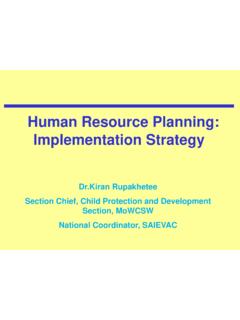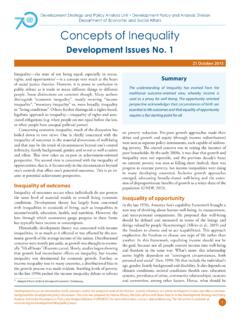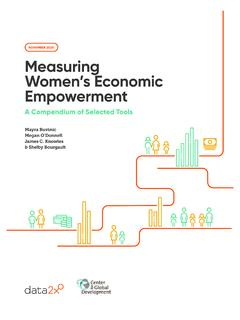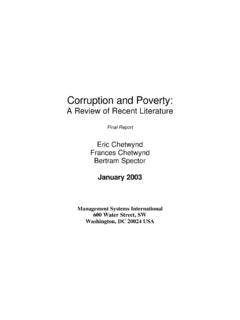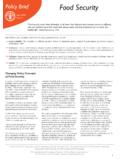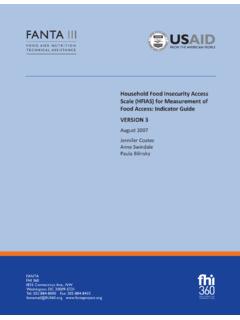Transcription of Poverty in Nepal: Characteristics and Challenges
1 Journal of Poverty , Investment and Development ISSN 2422-846X An International Peer-reviewed Journal , 2015. Poverty in Nepal: Characteristics and Challenges Trilochan Pokharel Nepal Administrative Staff College, Jawalakhel, Lalitpur, Nepal Email of the corresponding author: Abstract The official data as of 2010/11 affirms around 25 percent Nepali live under absolute Poverty line. The Poverty line is derived at annual per capita earning of $225 as of 2013 December. There are debates whether the Poverty line really defines basic necessities of survival. On contrary, the Human Poverty Index shows 44 percent of Nepali are deprived of basic education, health and access to resources.
2 Achieving sustainable human development is highly regarded and committed development goal in Nepal as elsewhere. However, the existing Poverty indicators are putting a serve challenge how really these goals can be achieved by a defined target of 2020. Distribution of Poverty across the country varies with high severity in rural mountain and low in urban areas. Despite illustrating development efforts, there is still a sharp divide in development inputs, process and outcomes. The development policies of Nepal have less room to criticise. However, the implementation status and results explain different but gloomy phenomenon. Being poor means having multiple Characteristics which denies recognition, share in resources and opportunities, participation in decision making and influencing the processes that affect themselves which as a result Challenges their survival freedom.
3 Empowering poor, disadvantaged and marginalized and developing their wealth asset including education, health and employment must be the central agenda of the development planning in Nepal in order to achieve sustainable human development. Keywords: Poverty , human development, Poverty gap, Challenges , Nepal 1. Background The recent Nepal Living Standard Survey (NLSS) 2010/11 shows that 25 percent of Nepali people are below the absolute Poverty line. The official monetary Poverty line in local prices is NRs 19,261 (Central Bureau of Statistics [CBS], 2011) per person per year. This is approximately 225 US dollars as of April 2013 transaction rate1.
4 It implies that a Nepali consuming approximately dollar a day is considered as non-poor. This level is far less than that of the World Bank's dollar a day measure, which the Bank terms as extreme Poverty . There are intra-country disparities in Poverty line and distribution. For example, the Poverty line is lowest (approximately 184 dollars) for the western southern plain and highest for capital city Kathmandu (approximately 471 dollars). There are more issues. The interesting one is that the Kathmanduities spend more on non-food items, almost double to food items against the higher expenses in food items for other parts. The proportion of people living below Poverty line is highest in the northern mountains while it is lowest for urban hill.
5 The western part of the country hosts higher proportion of poor compared to eastern part. If we use human development concept to measure the Poverty , the proportion of Nepali people living in Poverty is around percent in 2011 (National Planning Commission (NPC) [Government of Nepal] & United Nations Development Programme [UNDP], 2014). This is significant decline by more than 50 percent from as high as 65 percent three years ago (UNDP, 2011). However, there are vast differences in the measurement process and indicators in the both concepts. Nepal's official Poverty measurement is basically based on consumption approach which mainly uses basic calorie threshold.
6 It does not concern how the people maintain their basic living standard. It is also blind to whether there are public investments to enhance the capability so that they can sustain their fight against Poverty . In common sense, Nepal's official Poverty measurement practice deserves criticisms of money metric approach. 2. Objectives Despite the phenomenal and milestone efforts to make development process more people centred and multidimensional , Nepal is still struggling around upper bound of low human development countries. Around one quarter of total population survive a miserable life under absolute Poverty line, which is far less than the global $ a day standard.
7 This paper basically argues that the Poverty in Nepal is a critical issue that is restricting people to enjoy the freedom and choices and is challenge for achieving sustainable human development. In this paper, I will basically attempt to highlight socio-economic, spatial distribution and gender dimension of Poverty in Nepal. Although, my analysis will be based on Nepal's official practice of Poverty measurement , I will relate the Poverty analysis to broader perspective of human Poverty and its consequences to 1. Rates are obtained from Central Bank of Nepal from , accessed on 13 April 2013. 44. Journal of Poverty , Investment and Development ISSN 2422-846X An International Peer-reviewed Journal , 2015.
8 Human development. This paper also provides spaces for some cases that explain Poverty picture and its impact on sustainable human development. 3. Methods and materials Given the background, this paper basically illustrates the Characteristics and constraints, particularly focusing on Poverty , for achieving sustainable development. The data for this analysis are mainly derived from two sources - Nepal Living Standard Survey (NLSS) 2010/11 and Nepal Human Development Report (NHDR) 2009 and 2014. NLSS 2010/11 provides statistics on income based Poverty while NHDR 2009 and 2014 is used to derive the human Poverty index. In addition, other relevant sources as such as Nepal Economic Survey 2013 and the World Bank Online Database 2013 are used to supplement the analysis.
9 This paper uses two analytical approaches- descriptive and comparative. The descriptive approaches describes the status and situation of Poverty with some arguments for the situation while comparative approach makes relevant comparison based on geographical and other classifications. 4. Nepal in global Poverty map By virtue Nepal belongs to least developed region with high Poverty , persistent inequality and deprivation from basic facilities of health, education and economy. Despite the progress Nepal has made in recent days, the stories of Poverty and deprivation are still popular and remain popular for other several decades. In Asian context, many countries have comparable status with Nepal.
10 Except Sri Lanka in the region, around a quarter of population are below Poverty line with some countries having higher proportion (Figure 1). 40 36. 35. 30 26 25 20. 15. 10. 5. 0. Figure 1: Nepal in Asian Poverty map (% of population below national Poverty line). Source: World Bank, 2013. In the region, Afghanistan and Cambodia have higher proportion of population living below the Poverty line while other Bangladesh. Bhutan, India, Nepal and Pakistan have similar level of Poverty . But the decline may be faster for Bhutan because of recent economic development. Despite having appraising economic growth India and Bangladesh may have to struggle for long time because of large population based and persistent inequality among the population.
